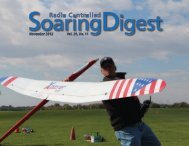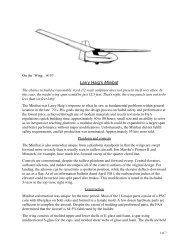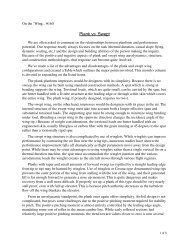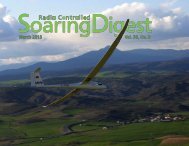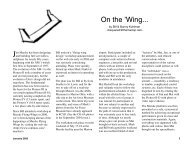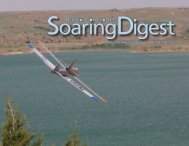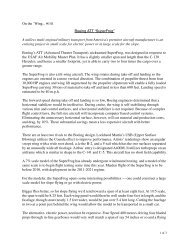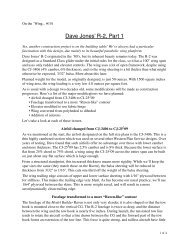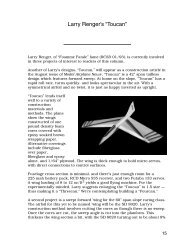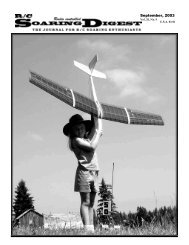Aug - Rcsoaring.com
Aug - Rcsoaring.com
Aug - Rcsoaring.com
You also want an ePaper? Increase the reach of your titles
YUMPU automatically turns print PDFs into web optimized ePapers that Google loves.
SoaringDigest<br />
Radi C ntr lled<br />
<strong>Aug</strong>ust 2010 Vol. 27, No. 8
CONTENTS<br />
<strong>Aug</strong>ust 2010<br />
Vol. 27, No. 8<br />
Front cover: The cover this month is a departure from the norm in<br />
that it is not a photograph. Rather, it is a piece of <strong>com</strong>puter artwork from<br />
Carlos Ribeiro of Brazil. Carlos created this image of an ASW-28, along<br />
with others presented on pages 44 through 47, using readily available<br />
software. Carlos is also involved in <strong>com</strong>puter animation through his<br />
<strong>com</strong>pany TWiST FX. Please visit to see<br />
a sampling of produced videos.<br />
3 RC Soaring Digest Editorial<br />
4 Black Eagle Trophy PSS Festival<br />
Kevin Farr tells the story behind this event which drew<br />
a large number of entrants and a variety of spectacular<br />
models. Photos ©Cobos Botha sponsored by WiFly.co.za<br />
and by Malcolm Riley, Peter Vergeer and Kevin Farr.<br />
Seattle Area Soaring Society<br />
21 F3J at Old Carnation Farm<br />
The drama and excitement of F3J with winches on June<br />
26 th at Old Carnation Farm (Camp Korey), the new home<br />
field for the Seattle Area Soaring Society. Coverage by<br />
Seth Arlow.<br />
Electrifying a Supra 26<br />
A relatively easy conversion detailed with text and photos<br />
by Gert Niewoudt.<br />
Mark Southall flying his Ascot 31<br />
A photograph by Pierre Rondel.<br />
Lift Ticket to Norway 32<br />
The Dave Reese/Reese Productions DVD reviewed<br />
by Paula Garwood.<br />
Updating the Ace MicroPro 8000 31<br />
A new and easily installed EPROM allows more<br />
transmitter programming options. A review by Pete Carr.<br />
The Art of Carlos Ribeiro 44<br />
Realistic RC sailplane drawings created by Carlos Ribeiro<br />
using Autodesk 3ds Max software.<br />
2 R/C Soaring Digest
R/C Soaring Digest<br />
Managing Editors, Publishers<br />
Contributors<br />
Photographers<br />
Contact<br />
B 2 Kuhlman<br />
Seth Arlow<br />
Peter Carr<br />
Kevin Farr<br />
Paula Garwood<br />
Gert Niewoudt<br />
Carlos Ribeiro<br />
Seth Arlow<br />
Cobos Botha sponsored by WiFly.co.za<br />
Pete Carr<br />
Kevin Farr<br />
Dave Reese/Reese Productions<br />
Malcolm Riley<br />
Pierre Rondel<br />
Peter Vergeer<br />
rcsdigest@centurytel.net<br />
Web: http://www.rcsoaringdigest.<strong>com</strong><br />
Yahoo! group: RCSoaringDigest<br />
AIM screen name: RCSDigest<br />
Microsoft Messenger: rcsdigest<br />
R/C Soaring Digest (RCSD) is a reader-written monthly publication for<br />
the R/C sailplane enthusiast and has been published since January<br />
1984. It is dedicated to sharing technical and educational information.<br />
All material contributed must be original and not infringe upon the<br />
copyrights of others. It is the policy of RCSD to provide accurate<br />
information. Please let us know of any error that significantly affects<br />
the meaning of a story. Because we encourage new ideas, the content<br />
of each article is the opinion of the author and may not necessarily<br />
reflect those of RCSD. We encourage anyone who wishes to obtain<br />
additional information to contact the author.<br />
Copyright © 2010 R/C Soaring Digest<br />
Published by B2Streamlines <br />
P.O. Box 975, Olalla WA 98359<br />
All rights reserved<br />
In the Air<br />
As many of you know from reading "Oncle" Sydney<br />
Lenssen's column last month, the Pacific Northwest<br />
will be without a significant portion of the Seattle Area<br />
Soaring Society for the next couple of weeks.<br />
All three of the US Junior F3J Team members (Brendon<br />
"Dippin' Dots" Beardsley, Michael "Chainsaw" Knight<br />
and Connor "Stealth" Laurel) are SASS members, their<br />
fathers are all <strong>com</strong>petitive RC sailplane pilots within<br />
SASS and will be serving either as team members or<br />
as support staff, and several other SASS members<br />
are either team members or are going to Dole-Tavaux<br />
aerodrome as enthusiastic spectators.<br />
The United States F3J Team, along with teams from<br />
other countries, will be leaving for France within the next<br />
few days.<br />
Best of luck to everyone at Dole-Tavaux, regardless of<br />
national origin!<br />
Coverage of the 2010 F3J World Championship will<br />
appear in a future issue of RCSD, perhaps as early as the<br />
September issue, but more likely October.<br />
A reminder... Please note the RCSD email address was<br />
recently changed. It is now .<br />
Time to build another sailplane!<br />
RC Soaring Digest is published using Adobe InDesign CS5<br />
<strong>Aug</strong>ust 2010 3
Black Eagle Trophy<br />
PSS Festival<br />
Hosted by Two Oceans Slope Soarers<br />
Cape Town June 19th and 20th 2010<br />
Kevin Farr, kevin@fvdv.co.za<br />
with photos ©Cobos Botha sponsored by WiFly.co.za,<br />
and by Malcolm Riley, Peter Vergeer and Kevin Farr<br />
THE IDEA<br />
The Black Eagle Trophy PSS Festival flew gracefully into the<br />
annals of the Cape slope soaring scene over the weekend of<br />
the 19th and 20th June 2010. With 21 pilots entered, the event<br />
promised to be packed as most pilots had two aircraft at least<br />
to add to the mix.<br />
Following the hosting and success of the second Two Oceans<br />
Slope Soarers Aerobatics event in January, it was felt that<br />
there should be more development in our club sphere, and<br />
driven by Damian Hinrichsen’s suggestions and constant<br />
requests for a relevant date, we set a date for a PSS event that<br />
was a good six months away from the Aerobatics event and<br />
slap bang in the middle of winter.<br />
The P-38 heads out on a video sortie. Cobos Botha photo<br />
4 R/C Soaring Digest
What a view from the event area. Photo by Kevin Farr<br />
<strong>Aug</strong>ust 2010 5
Left: A gaggle of warbirds over the Sentinal. Cobos Botha photo<br />
6 R/C Soaring Digest
Above: The kill. Photo by Peter Vergeer<br />
<strong>Aug</strong>ust 2010 7
Above: Anton Benning’s Impala on the cruise. Cobos Botha photo<br />
Right: Christo Le Roux and his P-40 Warhawk. Cobos Botha photo<br />
We were hoping to garner the standard winter North Westers that<br />
pepper this part of the world in association with each approaching<br />
frontal system. With the idea of hosting an event established, we<br />
decided to create the event around the impressive and threatened Black<br />
Eagles that grace our slopes in Cape Town as well as other parts of the<br />
country. Hence the Black Eagle Trophy PSS Festival by name and an<br />
agreement to donate a portion of each entry fee to the Percy Fitzpatrick<br />
Institute of African Ornithology, for the study and preservation of the<br />
varying raptor populations that inhabit the slopes we soar on.<br />
This followed our need to create a conservation platform within the<br />
slope soaring fraternity and give something back to the environment we<br />
utilize so readily.<br />
8 R/C Soaring Digest
Close-up shots of Christo Le Roux’s P-40 Warhawk showing the detail incorporated in his large scale model. Photos by Cobos Botha<br />
THE PLAN<br />
With the TOSS <strong>com</strong>mittee firmly set on<br />
a course of action, the planning started,<br />
the rules and documents created, the<br />
contestants entered, and many entrants<br />
started the mammoth task of getting their<br />
pride and joy slope soarers ready for the<br />
<strong>com</strong>petition that was barely six months<br />
away.<br />
Based on the three available classes,<br />
Foamy, Sportsman and Expert class,<br />
with a lot of scratch building as well<br />
as revamping and total overhauling of<br />
ARF kits began in order to match each<br />
available class.<br />
Being a bit of a foamie <strong>com</strong>bat club,<br />
Damian Hinrichsen had the vision of<br />
creating a fleet of slope warbirds that<br />
were EPP foam based, allowing for<br />
the <strong>com</strong>bat zone to be filled with the<br />
sight of scale warbirds in hot pursuit of<br />
each other. With this in mind he quickly<br />
went about drawing up the plans for<br />
at least 10 different warbirds ranging<br />
from the indomitable Spifitre to the<br />
Zero, with Mustangs, P40 Warhawks,<br />
Messerschmitts, Focke-Wulfs and many<br />
more thrown into the mix. Along with the<br />
well known slope aeromodeller Anton<br />
Benning, they cut the initial fuselage<br />
shapes while Anton created the wings,<br />
wing spars and relevant pushrod systems<br />
as part of these fantastic little kits.<br />
With huge enthusiasm the entire field of<br />
entries got about building these foamy<br />
slope soarers which proved to be brilliant<br />
in their simplicity and saw the black<br />
EPP foam being taken down to shape,<br />
covered with Orocover, given the relevant<br />
decals, and dusted with a protective<br />
varnish for the final finish.<br />
Panel lines and detail became part of the<br />
build and many superbly finished models<br />
rolled off the desktop line and into the<br />
foamy class, ready for the inevitable<br />
battle.<br />
<strong>Aug</strong>ust 2010 9
Above: A foamy Mustang. Cobos Botha photo<br />
Right: Lionel Brink and his large scale Tucano. Cobos Botha photo<br />
There was a stark dearth of slopers on the slopes in the weekends<br />
leading up to the event as many of the pilots hid in dark corners<br />
concentrating on the large scale warbirds, finalized each with<br />
delicate detail that annoyingly seemed to take longer than it should .<br />
THE BIG SHOW<br />
A beautiful morning dawned on the 19th July 2010 in our part of<br />
the world. A few intrepid slopers were seen on the slopes as early<br />
as 7:15 am staring into the dark while awaiting the arrival of dawn<br />
and the first few flights of the day. Our skinny little Cape Peninsula<br />
is such a sitter for a good North Wester and mother nature duly<br />
delivered. Not a howler by any note, but with more than sufficient<br />
10 R/C Soaring Digest
Damian Hinrichsens immaculate ME109. Cobos Botha photo<br />
<strong>Aug</strong>ust 2010 11
Marc clears off the dust before relaunching the Zero. Cobos Botha photo<br />
Herbie Newton, static judge for the day.<br />
Cobos Botha photo<br />
lift to start the event and take whatever<br />
the day threw at us. Early morning<br />
was light but flyable and the foamies<br />
entered the judging area and were duly<br />
awarded points by the static judge<br />
for the day, Herbie Newton, and then<br />
released skywards to open up a days<br />
warbird <strong>com</strong>bat that was to prove hugely<br />
successful.<br />
These foamy warbirds were sometimes<br />
incredible in their detail and realism as<br />
applied by the differing individuals and<br />
proved an absolute revelation in the light<br />
lift and gaining more attributes as the<br />
lift improved throughout the day. One<br />
<strong>com</strong>petitor racked up three and a half<br />
hours of flight time from maiden flight to<br />
the end of the day’s proceedings. Some<br />
kind of stick time, that.<br />
This was followed by the Sportsman<br />
class that was punctuated by the two<br />
meter plus class of plane with some<br />
great renditions entered; from the<br />
Mustangs of Damian Hinrichsen and<br />
Bobby Purnell to Malcolm Riley and<br />
12 R/C Soaring Digest
One of the Mustangs caught in flight. Cobos Botha photo<br />
<strong>Aug</strong>ust 2010 13
The P-38 homeward bound. Photo by Malcolm Riley<br />
Anton Benning’s Impalas, Lionel Brink’s<br />
Tucano, Chris Leal’s Me 109, Carlo<br />
Davis’s Sea Fury and A10 Warthog, and<br />
Marc Beckenstrater’s enviable Mosquito.<br />
The premise being that ARF kits could<br />
be entered, and in true fashion some<br />
stunning conversions of power kits hit<br />
the slope. Toss away the motor, add vast<br />
amounts of lead and away we go.<br />
That not being enough, large amounts of<br />
detail were then added to create realistic<br />
interpretations that go well beyond<br />
simple ARF’s. Some, such as Dave Greer<br />
from Durban, scratch built a lost foam<br />
ME 109 and entered the class as well.<br />
In general the standard of the models<br />
was extremely high and were presented<br />
beautifully in all their glory. The final class<br />
was the Expert class, again made open<br />
to the ARF’s and scratch built, but with<br />
the emphasis based on detail, detail,<br />
detail.<br />
In this class only two intrepid individuals<br />
entered who felt that their application<br />
to detail as required in the class<br />
designations was up to scratch as<br />
it were. Christo Le Roux entered a<br />
magnificent P40 Warhawk that had to be<br />
seen to be believed, with a sound system<br />
incorporated that had all and sundry<br />
titivated as the “engine” spooled up,<br />
gained speed to full revs and then had<br />
the ability to emit a wail of gunfire.<br />
The second entrant was Steve Meusel’s<br />
scratch built Polikarpov I-15. This beaut<br />
of a subject was a first for us slope folk<br />
14 R/C Soaring Digest
Steve Meusel and the Polikarpov I-15. Cobos Botha photo<br />
Marc Beckenstrater and the Mosquito. Photo by Malcolm Riley<br />
<strong>Aug</strong>ust 2010 15
Left: A Sea Fury awaits some wind. Cobos Botha photo<br />
Above: Sunday morning glory. Cobos Botha photo<br />
this side of the world, and given the fact that none of us have flown<br />
a biplane on the slope, proved to be a much debated subject.<br />
During the day the wind grew in strength but still maintained a bit of<br />
an on and off affair, but by mid afternoon was more than sufficient<br />
to see Anton Benning flying his small scale Impala for increased<br />
periods of time.<br />
With a chance for flight and with the wind just being sufficient, the<br />
P-38 Lightning took to the air with a camera mounted on board, had<br />
a half hour flight till the lift once again proved a little light for this 30<br />
oz wingloading warbird and the inevitable landing had to be applied.<br />
16 R/C Soaring Digest
Left: A few of the foamies that were present. Cobos Botha photo<br />
Above: Damian Hinrichsen stares into the future. Cobos Botha photo<br />
In the end there was just a shade too little lift to expect the guys to<br />
maiden large scale warbirds on the day, but a week later in insane<br />
lift at the St. James site and on the back of a 60km/h wind, every<br />
single one of the warbird gliders took to the air to prove their mettle.<br />
They all flew like a dream and the big surprise of that day was to<br />
see the Polikarpov biplane tearing up the air with grace.<br />
On the PSS day the <strong>com</strong>bat zone and the foamies ruled the sky,<br />
many a beating was taken, many a fetch had from down the slope,<br />
and humour and strapping tape ruled the day till sunset forced the<br />
closure of the slope. The shadows were lengthening and evening<br />
approached with a few individuals still on the slope nattering away,<br />
when the mascot of the festival arrived in the growing dark.<br />
<strong>Aug</strong>ust 2010 17
The entrants and their warbirds. Cobos Botha photo<br />
The Black Eagle Trophy. Photo by Kevin Farr<br />
18 R/C Soaring Digest
Cobos Botha photo<br />
A large Black Eagle flew in right over our<br />
heads as if in blessing and circled it’s<br />
way up the peak in the dusk without so<br />
much as a wing beat, amply showing us<br />
landlubbers the true art of flight.<br />
The sunburnt and somewhat tired<br />
individuals then headed for a meal at<br />
Dixie’s to swap war-stories while sipping<br />
a relaxer.<br />
Sunday dawned as beautiful as Saturday<br />
without a single cloud in the sky, but<br />
the wind gods deserted us and only the<br />
very lightest of gliders were able to stay<br />
up as mist moved in an enveloped the<br />
bay. A healthy breakfast was on offer<br />
and general natter filled the air while all<br />
waited for even the slightest whiff of wind<br />
and the electric gliders plied vertical<br />
power in place of lift.<br />
Mid morning saw the conditions<br />
unchanged and the awards ceremony<br />
then took place.<br />
THE AFTERMATH<br />
The first order of business was to hand<br />
over the cheque for the sum of<br />
R 2500-00 to Dr. Rob Simmons and Dr.<br />
Andrew Jenkins of the Percy Fitzpatrick<br />
Institute of African Ornithology, based at<br />
the University of Cape Town, which was<br />
gracefully accepted. Due to the presence<br />
of a few of the raptor research specialists<br />
on the slope for most of the morning,<br />
a great relationship was established<br />
that bodes well for slope soaring’s<br />
involvement with the research institute<br />
itself, as well as future investments in the<br />
protection and study of the raptors that<br />
grace our slopes.<br />
With the generous sponsorship of the<br />
hobby shops, people involved in the<br />
sport and the members of Two Oceans<br />
Slope Soarers, we were blest with ample<br />
prizes to give out in all categorizes from<br />
first to third as well as spot prizes based<br />
on TOSS <strong>com</strong>mittee decisions for those<br />
spot prizes.<br />
<strong>Aug</strong>ust 2010 19
The prize winners were as such and<br />
well done to them all for the effort<br />
instituted in creating the PSS model of<br />
note that garnered the desired results.<br />
Expert Class:<br />
1. Steve Meusel - Polikarpov i-15<br />
2. Christo Le Roux - P40 Warhawk<br />
Sportsmans Class:<br />
1. Marc Beckenstrater - Mosquito<br />
2. Bobby Purnell - Mustang<br />
3. Chris Leal - Me 109<br />
Foamy Class:<br />
1. Bill Dewey - Heine<br />
2. Christo Le Roux - Mustang<br />
3. Marc Beckenstrater - Zero<br />
And to all our sponsors and Two<br />
Oceans Slope Soarers members who<br />
selflessly helped to create a fantastic<br />
festival, our gratitude for being actively<br />
involved in the resurgence of PSS in the<br />
Cape Town area.<br />
Hobby Warehouse, Clowns Hobbies,<br />
Southern Hobbies, Anton Benning of<br />
AB models, Christo Le Roux, Steve<br />
Meusel for the warm beenies, Chris<br />
Leal for financial support of the Black<br />
Eagle fund, and Kevin Farr and Iris van<br />
der Vlist for design and print of the<br />
t-shirts. If there are any sponsors and<br />
diligent supporters we have failed to<br />
acknowledge, please forgive us.<br />
Here’s looking forward to next year and<br />
more success with PSS.<br />
Cobos Botha photo<br />
20 R/C Soaring Digest
Seattle Area Soaring Society<br />
F3J at Old Carnation Farm<br />
Seth M. Arlow, M.D., arlow2@msn.<strong>com</strong><br />
Anyone who has flown a contest knows that a few minutes’<br />
separation in launching times can make the difference<br />
between making your time with ease, and sinking out like a<br />
rock, not to mention gusts blowing through the landing zone<br />
when you’re on final!<br />
F3J removes that element from the equation: pilots in each<br />
group launch at the same time, have identical tasks, fly in the<br />
same air, and, if they make it, land at the same time.<br />
<strong>Aug</strong>ust 2010 21
The 2010 F3J<br />
Junior Team: Mike<br />
“Chainsaw” Knight,<br />
Brendon “Dippin’ Dots”<br />
Beardsley, and Connor<br />
“Stealth” Laurel<br />
Alyssa “Shark Bait”<br />
Wulick, Brendon<br />
“Dippin’ Dots”<br />
Beardsley, Daryl<br />
Perkins and Cody<br />
Remington discuss<br />
the Airtronics SD-10G<br />
radio system while CD<br />
Dave Beardsley keeps<br />
the contest running<br />
smoothly.<br />
This makes for drama and<br />
excitement, and there was plenty of<br />
both on June 26 th at Old Carnation<br />
Farm (Camp Korey), the new home<br />
field for the Seattle Area Soaring<br />
Society.<br />
In addition to the “usual suspects,”<br />
the SASS soaring regulars, we<br />
were joined by soaring legends<br />
Daryl Perkins and Cody Remington,<br />
two of the senior members of the<br />
2010 US F3J Team. Their visit was<br />
thanks to Jim Laurel, to whom all<br />
SASS members are very grateful.<br />
Of course the entire Junior US F3J<br />
team was there: Mike “Chainsaw”<br />
Knight, Brendon “Dippin’ Dots”<br />
Beardsley, and Connor “Stealth”<br />
Laurel. The Senior Canadian F3J<br />
team also flew — VERY well!<br />
The contest started off with a bang<br />
— literally! Two very skilled and<br />
experienced pilots, Dave Friant<br />
and Ole Skotvold, launched next<br />
to each other, that is to say 75 feet<br />
apart, and their planes collided just<br />
after launch. The impact was like a<br />
thunderclap, and both planes were<br />
destroyed. Bits of Dave’s brand<br />
new Competition Light Supra rained<br />
down for over a minute, and Ole’s<br />
Pike Superior was all but cut in half.<br />
It was a shocking and heartbreaking<br />
moment, aside from being a very<br />
rare event. Ole returned to the<br />
contest with his non-molded back<br />
22 R/C Soaring Digest
up plane, and Dave has pledged to<br />
return to the field once the grieving<br />
is past.<br />
The contest proceeded without<br />
incident afterwards. All tasks were<br />
ten minutes with spot landings.<br />
There was a 30 point penalty for<br />
flying over ten minutes, which means<br />
that, tactically, it is better to land,<br />
even off field, if you’re running over<br />
your time.<br />
The first two rounds were in cloudy<br />
but dry conditions; the remaining<br />
two rounds were in clear sunlight.<br />
Four or five pilots flew at a time, in<br />
randomized groups, and the scores<br />
for each round were normalized,<br />
with the best performing pilot getting<br />
1000 points.<br />
As might be expected, given the<br />
expertise of the contestants, the<br />
scores of the top experts were very<br />
close. The winner, Arend Borst,<br />
Canadian National Champion,<br />
scored an amazing 3999.57 out of<br />
a possible 4000 points. He lost<br />
the 0.43 points short of perfection<br />
thanks to Dave Beardsley, the<br />
Contest Director, who flew a<br />
stunning first round before retiring to<br />
run the contest.<br />
Cody Remington and Daryl Perkins,<br />
of the US Team, took second and<br />
third.<br />
Jim Laurel and<br />
Dave Beardsley<br />
Daryl Perkins<br />
ready to launch<br />
off one of the new<br />
SASS winches.<br />
<strong>Aug</strong>ust 2010 23
Brendon Beardsley<br />
launches Daryl<br />
Perkins’ Supra.<br />
Simultaneous<br />
launches were<br />
the norm for this<br />
contest, just as<br />
in regular F3J<br />
<strong>com</strong>petition.<br />
24 R/C Soaring Digest
Alyssa “Shark Bait”<br />
Wulick, templates<br />
in hand, gets her<br />
Supra control<br />
surfaces set up<br />
with the help of<br />
grandfather Bill<br />
“Papa” Kuhlman.<br />
Alyssa is planning<br />
to <strong>com</strong>pete in the<br />
F3J Junior Team<br />
Trials next year.<br />
Despite the<br />
intensity of the<br />
contest, there<br />
was time for<br />
some relaxation.<br />
US Junior Team<br />
aircraft are in the<br />
foreground.<br />
To give an idea of how tight scoring can<br />
be, the fourteenth place finisher had two<br />
perfect rounds; the fifteenth had three<br />
(out of four) perfect rounds. Consistency<br />
is key!<br />
In Sportsman class, Paul Measel was a<br />
solid lead at the halfway point, before<br />
inconsistency struck. Seth Arlow and<br />
relative new<strong>com</strong>er Larry Eich finished<br />
first and second, separated by barely<br />
seven points.<br />
The increased prominence of<br />
<strong>com</strong>petition flying at SASS has been<br />
noted, particularly with the excitement<br />
generated by “The Boys” earning<br />
selection to the US F3J Team for the<br />
World Championship in France this<br />
summer. Some feel that this has deemphasized<br />
recreational flying.<br />
As a middling “stick” I can only repeat<br />
the old, but true adage: regardless of<br />
your skill level, you will learn more in<br />
minutes of <strong>com</strong>petition flying than you<br />
will learn in hours of casual flying.<br />
Thanks to all who made this such a<br />
great day — Dave Beardsley, CD and<br />
party organizer, Jim Laurel, who made<br />
Cody and Daryl’s visit possible, Doug<br />
Brusig, field cook and “the human line<br />
retriever,” Rick Helgeson and his field<br />
mowing team, and winch designer/<br />
builder Mark Vance, with Rick Como<br />
— the matched winches performed<br />
flawlessly!<br />
<strong>Aug</strong>ust 2010 25
Electrifying<br />
a<br />
Supra<br />
Gert Nieuwoudt, gnieuwoudt@telkomsa.net<br />
I have been playing with electric models<br />
since the late ’90s. Since I have a<br />
glider passion it naturally spilled over<br />
to electrifying my gliders as well. By<br />
now I had several models with which I<br />
<strong>com</strong>peted in e-glider events.<br />
Most of my models were done on a<br />
limited budget with most of my moneys<br />
still going for a model in the open class.<br />
With the Nats <strong>com</strong>ing up in September<br />
and all the talk about the FAI rule for a<br />
new e-glider class, my fingers got itchy<br />
to get a better model together.<br />
This year we also allowed e-gliders with<br />
height limiter to participate in the postals<br />
alongside the winch launch models.<br />
My previous model was a home-built put<br />
together from parts I had laying in the<br />
garage. It is a 2.5m built-up E205 wing<br />
with a fuselage and boom construction<br />
similar to the Bubble Dancer.<br />
26 R/C Soaring Digest
<strong>Aug</strong>ust 2010 27
28 R/C Soaring Digest
The model was put together as light as<br />
possible in order to have a small power<br />
house zoom it in the shortest time<br />
possible to 200m. The 400 watt power<br />
plant achieved this with the 1.1kg model<br />
in less than 10 seconds. I was able to<br />
achieve second place in last year’s Nats<br />
with this model. This model is, however,<br />
not suited for windy weather and is<br />
limited to good weather days which never<br />
happen in <strong>com</strong>petitions.<br />
Flying a new Explorer in the thermal<br />
league, my Supra was gathering dust<br />
which made me figure out a new use for<br />
the model and other parts I have.<br />
I converted a home-built Supra fuselage<br />
in a short time to house the power plant<br />
in the nose cone.<br />
I removed the servos for rudder and<br />
elevator from the servo tray and removed<br />
the servo tray to have space for a 4-cell<br />
2200mAh LiPo battery pack — the<br />
largest battery I was able to fit in the<br />
space.<br />
The servos were installed in the rudder<br />
base with one 4-wire servo lead running<br />
inside the boom. The nose cone was cut<br />
and fitted with a firewall to fit an E-Flight<br />
15 outrunner. The motor and speed<br />
control is fixed to the nosecone which<br />
slides over the battery tray created from<br />
the servo tray. The speed control is fixed<br />
with Velcro to the top inside of the nose<br />
cone and sits on top of the battery once<br />
closed.<br />
The largest part of the nosecone is<br />
50mm in diameter so everything fits tight.<br />
I had many trial fits and re-adjustments<br />
until I was successful.<br />
The 13x8 folding prop uses a 42mm<br />
Graupner spinner. The nose cone with<br />
motor is now fixed with a plastic bolt<br />
from the bottom into the battery tray. The<br />
receiver is pushed back into the fuselage.<br />
I use a 4-cell Lipo battery to power the<br />
motor, but make use of the balancing<br />
connector to connect two cells via a<br />
BEC to power the receiver and servos.<br />
One of the other cells I use to power my<br />
altimeter logger.<br />
Getting all this connected and closed up<br />
is actually very easy now that I had some<br />
practice with it at the field. I only do this<br />
once and do all my flying before any<br />
disconnection and switch off.<br />
<strong>Aug</strong>ust 2010 29
Reaching any of the <strong>com</strong>ponents is easy<br />
as the nosecone with motor and speed<br />
control can be removed by disconnecting<br />
and the battery can then be accessed. I<br />
was able to position all the <strong>com</strong>ponents<br />
such that the CG is more or less at<br />
the preferred spot without adding any<br />
additional lead.<br />
I had a few flights already in the past<br />
week and after the initial trimming of the<br />
flight modes (I do not need launch mode<br />
anymore!) I was very pleased with the<br />
results.<br />
The model came out at 2050g AUW<br />
so it flies a bit faster than I am used<br />
to with the Supra. The 430W power<br />
plant launches the model to 300m in 30<br />
seconds as per the attached graph from<br />
my alti-logger. This is good enough for<br />
now but can be improved for <strong>com</strong>petition<br />
purpose.<br />
I use about 1200 mAh from the battery<br />
for an afternoons launches. The motor<br />
with this setup use an average 30A.<br />
My motor function is connected to the<br />
butterfly switch on my transmitter so it is<br />
either on full throttle or off.<br />
By using less expensive <strong>com</strong>ponents I<br />
proved that you do not need to break<br />
the bank to own and enjoy a <strong>com</strong>petitive<br />
electric glider.<br />
What a breeze to go out to the field for<br />
a quick practise session after work. As<br />
I am the lone glider pilot in this area it<br />
is quite a shlep to drag the winch and<br />
battery out to the small field (actually<br />
a power model field) and do the setup<br />
each time.<br />
I can also launch immediately after a<br />
landing and do not have to fetch the line<br />
for the winch. All in all I get more flying<br />
time!<br />
Time to build a new glider again.<br />
Cheers<br />
Gert Gnieuwoudt<br />
Secunda, South Africa<br />
30 R/C Soaring Digest
Mark Southall flying his Ascot during an F3F practice session at Rhossili Point, South Wales (GB). Rhossili is located<br />
at the most Western part of the Gower Peninsula. The slope is one of the most beautiful I have seen — coastal site, for<br />
west wind direction, and the view is superb! Pierre Rondel photo. Canon Powershot A650 IS, ISO 80, 1/500 sec., f6.3<br />
<strong>Aug</strong>ust 2010 31
32 R/C Soaring Digest
A review by Paula Garwood<br />
“Lift Ticket to Norway,” is a video which<br />
documents a three-week slope soaring<br />
trip in Norway, covering many miles over<br />
the road by van, and over the waves<br />
by ship. The video demonstrates, and<br />
documents in a visually spectacular way,<br />
slope soaring locations that make the<br />
imagination soar.<br />
The main characters are Dave Reese,<br />
Bob and Darcy Bingham from California,<br />
and Espen Torp from Norway. Other<br />
flyers from around Norway make<br />
appearances as well. The trip is well<br />
documented by three videographers and<br />
two still photographers.<br />
Whoa… before I go any further let me<br />
declare that I am not a slope soarer, but<br />
the wife of a slope soarer and although I<br />
am not a slope soarer, by being married<br />
to one for decades I am amazed at<br />
how much I actually know about slope<br />
soaring.<br />
My husband (the slope soarer) is a<br />
personal friend with Dave Reese. Dave<br />
Garwood has flown with Dave Reese in<br />
Utah and in California. My husband Dave<br />
admires Dave Reese and finds him to be<br />
a talented, cheerful, and energetic fellow,<br />
as well as a first rate glider pilot.<br />
<strong>Aug</strong>ust 2010 33
On this three week trip that you get to<br />
enjoy vicariously by watching the video,<br />
they fly 17 model airplanes, including<br />
sailplanes, electrics, and a helicopter.<br />
Approximately 19 flying locations are<br />
shown, including epic locations like the<br />
1100 meter Troll Wall - the tallest rock<br />
face in Europe, flying over fjords with<br />
cruise ships below, and slope soaring<br />
ABOVE the clouds.<br />
The flying is absolutely spectacular.<br />
They include dynamic soaring, fabulous<br />
hand catching, and a 2300 foot Drop<br />
Shot (when the wind wasn’t right). Really<br />
exciting stuff and fun to watch. In all the<br />
slope videos that I’ve seen, the pilot is<br />
just standing there at the edge. That<br />
part looks the same, but in this video<br />
you have the SCENERY. Norway is<br />
positively gorgeous. The scenic views<br />
and landscapes are overwhelmingly<br />
breath taking. A wife/partner could watch<br />
and enjoy this fully with their pilot. I kept<br />
saying “Look at that, that’s beautiful.”<br />
I don’t want to minimize the role of<br />
the pilots here either. They would walk<br />
out onto these rock ledges or cliffs,<br />
hundreds of feet high and LEAN OVER<br />
the edge (holy crap!) to test the wind and<br />
hand launch their planes. I personally like<br />
the purity of hand launch, so these guys<br />
impressed the hell out of me.<br />
There is dialogue. These guys are clever<br />
and articulate and had fun ribbing each<br />
other while deciding where to fly, what<br />
34 R/C Soaring Digest
<strong>Aug</strong>ust 2010 35
36 R/C Soaring Digest
to fly and how to fly it. I particularly<br />
fell in love with Espen’s endearing way<br />
of continuously helping every friend,<br />
<strong>com</strong>panion, and acquaintance, plus his<br />
cool accent. Bob Bingham is one cool<br />
dude as well, laid back and <strong>com</strong>petent,<br />
and a top gun glider pilot.<br />
The music was perfect. I will say it again,<br />
the music was perfect. The selections<br />
went with the flow of the video and<br />
the flying. The music was relaxing and<br />
melded smoothly within the driving,<br />
talking, flying sequences. The actual<br />
sound was crisp and clean and just a<br />
total pleasure.<br />
I want to go to Norway now, just to walk<br />
around and look at all the awesome<br />
topography. It’s striking, like nothing I’ve<br />
ever seen (except in Lord of the Rings<br />
movies).<br />
What a trip! Three weeks, 17 planes, 19<br />
flying locations, flying above the clouds,<br />
dynamic soaring, hand launching, hand<br />
catching, a Drop Shots more. A totally<br />
cool trip, cool video, expertly executed.<br />
Get it, watch it, you will be glad you did.<br />
LINKS:<br />
Dave Reese Productions<br />
www.reeseproductions.<strong>com</strong><br />
Still photos from the trip to Norway<br />
http://picasaweb.google.no/aerotorp/<br />
LiftTicketToNorway#<br />
<strong>Aug</strong>ust 2010 37
Updating the<br />
Ace MicroPro 8000<br />
Transmitter<br />
By Pete Carr WW3O, wb3bqo@yahoo.<strong>com</strong><br />
38 R/C Soaring Digest
Dan Thompson, WB4GUK, has been<br />
a moderator of the MP8K/M*2K Yahoo<br />
Group for several years. I finally met<br />
him in person at the 2010 Toledo Show<br />
along with many others from the Group.<br />
While the main focus of the Toledo<br />
meeting was the migration to 2.4 GHz RF<br />
link, there was some discussion about<br />
upgrade chips for the old MicroPro 8000<br />
encoder. This subject was installed at the<br />
top of my to-do list of projects.<br />
The MicroPro transmitter was a<br />
breakthrough in the industry because it<br />
offered <strong>com</strong>puter mixing of controls and<br />
an LCD display to interface with the pilot.<br />
It also was a kit so people who like to<br />
“melt metal” (solder) could build our own.<br />
The <strong>com</strong>panion receiver was the single<br />
conversion Silver Seven, and later<br />
the MicroPro 810 which was double<br />
conversion.<br />
The entire kit was developed using a<br />
procedure that had the builder check off<br />
each step in the building process. There<br />
was also extensive coverage of test<br />
equipment used to troubleshoot the radio<br />
if needed.<br />
Many of us who built the various<br />
Ace kits will admit that they learned<br />
as much about test equipment and<br />
troubleshooting as they did about the<br />
radios. For that reason there is an<br />
abundance of “warm’n fuzzy” feelings<br />
about the Ace and the MicroPro in the<br />
R/C <strong>com</strong>munity.<br />
Several weeks ago I e-mailed Dan<br />
about obtaining an upgrade chip for my<br />
transmitter. He replied that I could send<br />
him a check and he would send it right<br />
out. I did that and the chip arrived in one<br />
of those Post Office Flat Rate boxes.<br />
In keeping with<br />
today’s internetoriented<br />
world there<br />
was no paperwork<br />
enclosed with the<br />
chip. Installation and<br />
initialization of the<br />
new chip is covered<br />
in the original user<br />
manual for the<br />
MicroPro.<br />
The design of 25 years ago already saw<br />
the need to modernize the software and<br />
made provisions to swap the chip in the<br />
field.<br />
Working with EPROM (Erasable<br />
Programmable Read Only Memory)<br />
chips does require some care. Modern<br />
chips have protection against static<br />
electricity damage; still, some reasonable<br />
precautions should be taken to drain the<br />
static from your hands during installation.<br />
This is easily done by clearing all but the<br />
needed tools from your bench. I normally<br />
have a towel on the table as a work<br />
surface but that can generate static so it<br />
was removed.<br />
Once you are settled at the bench,<br />
remove the transmitter case back panel<br />
being very careful to disconnect the two<br />
cables to the RF deck. My rig also uses a<br />
The MicroPro transmitter was a<br />
breakthrough in the industry because<br />
it offered <strong>com</strong>puter mixing of controls<br />
and an LCD display to interface with<br />
the pilot.<br />
3-pin Deans connector in the cable from<br />
the 9.6 volt battery to the on-off switch.<br />
The battery is located just below the RF<br />
deck on the back panel so must also be<br />
disconnected.<br />
Dan had shipped the new chip inside a<br />
static-free carrier taped with Scotch tape<br />
to seal the ends. He had also sent along<br />
a large paper clip with one end bent at<br />
90 degrees. This was the extraction tool<br />
to remove the old chip from its socket. I<br />
This is the Kestrel two-meter sailplane with the Ace MicroPro 8000. Testing a new radio or checking out a repaired/upgraded one is<br />
easier when the aircraft is a proven design with no bad habits.<br />
<strong>Aug</strong>ust 2010 39
The Ace MicroPro transmitter has the new EPROM chip<br />
installed. It is located in the lower right side of the encoder<br />
board with the label indicating the version number. The area<br />
around the chip socket is crowded so take your time with the<br />
install.<br />
The new chip is in the socket while the old chip sits in the static<br />
protected holder next to the transmitter. You may slide the RJ-<br />
45 connector up and out of the transmitter case right side to<br />
give easier access to the socket area.<br />
removed the tape but left the chip inside<br />
its carrier. To prevent static damage<br />
I held onto the aluminum transmitter<br />
case with one hand at all times so any<br />
charge would drain away. I used to have<br />
a static drain wrist strap that connected<br />
to ground and did the same thing. If you<br />
don’t have a wrist strap this procedure<br />
works just as well.<br />
Using the bent paper clip I pried the<br />
end of the EPROM chip up a little, then<br />
moved to the opposite end and pried that<br />
up. I worked alternately to raise the chip<br />
gradually from the socket until it popped<br />
free. I then set the old chip down on the<br />
bench with its pins upward.<br />
The new chip has a label on top and a<br />
small indent to the left side. The new chip<br />
needs to go into the socket on the circuit<br />
board with the label right side up and the<br />
indent on the left.<br />
The work area on the board is crowded<br />
with the RJ-45 connector, Sonalert, and<br />
another chip close to where the new chip<br />
goes.<br />
Take your time and verify that all the chip<br />
pins are properly aligned with the socket.<br />
Once aligned you can simply press the<br />
chip down into the socket. Take your time<br />
and check that no pins have folded up<br />
under the chip.<br />
40 R/C Soaring Digest
The MicroPro sits in its carrying case along with the operations<br />
manual. I carry the manual since some features are hard to<br />
program from memory.<br />
This is the rear cover of the transmitter. The frequency label is<br />
located where the RF deck is installed inside. Below and to the<br />
left is the charge jack. Inside and next to the charge jack are<br />
two 4-cell square packs wired for 9.6 volts and attached to the<br />
cover with Velcro hook and loop material.<br />
Once you are satisfied that the<br />
installation is correct reconnect the<br />
cables to the transmitter rear panel and<br />
close it up.<br />
The Ace User Manual, page 54,<br />
discusses the software upgrade and<br />
install of the EPROM.<br />
This is followed by a procedure to set the<br />
joysticks and initialize the EPROM. These<br />
are fairly simple. If the expected results<br />
don’t appear in the LCD display just start<br />
over again. You can’t hurt the chip or the<br />
radio.<br />
The old Ace chip would sound the<br />
Sonalert once on power-up. The new one<br />
sounds two beeps from it. That tells you<br />
that the chip has powered up okay. From<br />
there you can scroll through the menus<br />
to see what the new chip holds.<br />
I’ve wanted to explore the use of two<br />
elevator servos with two independent<br />
elevators as used on some of the<br />
advanced 3D aerobatic ships. The old<br />
chip didn’t support this arrangement<br />
but the new one does. That is a small<br />
example of the modern features that<br />
await you with this upgrade.<br />
Dan has uploaded a PDF file that fully<br />
explains the details of the new chip<br />
programming and features. To obtain this<br />
file go to www.yahoo.<strong>com</strong>, then Groups,<br />
then MP8K, then Files, then MP8KL7.pdf.<br />
The 24 page file gives you the information<br />
<strong>Aug</strong>ust 2010 41
needed to tailor the radio to the needs of<br />
your particular model.<br />
It’s so nice to be able to enter the name<br />
of the aircraft in the transmitter LCD<br />
display instead of having to remember<br />
which program number goes with which<br />
aircraft. I used to have to carry a card in<br />
the transmitter bag with the names and<br />
numbers, but the new chip does that for<br />
me now.<br />
The main menu of programming options<br />
is very similar to the old one. If you scroll<br />
through the options you will find a sub<br />
menu which is where the new goodies<br />
are located.<br />
Option selection is done using the aileron<br />
stick along with the trim, option, and<br />
preset switches.<br />
Experienced Ace MicroPro pilots will<br />
quickly adjust to the new sequences<br />
while newer ones will be thrilled at the<br />
simplicity of the operations. Dan’s file is<br />
very well organized. Should you have any<br />
questions you can always e-mail him at<br />
WB4GUK@aol.<strong>com</strong>.<br />
The MicroPro encoder is the interface<br />
that connects the pilot’s fingers to<br />
the aircraft. It should be a seamless<br />
extension of the pilot’s <strong>com</strong>mands.<br />
When the original encoder was produced<br />
there were defined limits on these<br />
<strong>com</strong>mands. Some of it was technology<br />
and some of it was the learning curve we<br />
all were climbing.<br />
Things are much better now on both<br />
fronts. It’s now possible to know what<br />
you want to achieve and easy to make<br />
the radio send your desires to the<br />
aircraft.<br />
I decided to take an old three channel<br />
ship out for testing with the upgraded<br />
MicroPro. It’s a two meter sailplane kit<br />
called a Kestrel which was bought many<br />
years ago from Northeast Sailplanes at<br />
www.nesail.<strong>com</strong>. I modified the design to<br />
have a flying stab, sheeted rib/spar wing<br />
and flaps. The ship is about 15 years old<br />
and has served me very well.<br />
I installed the radio in the Kestrel and set<br />
up throttle to elevator mixing as well as 5<br />
degrees of flap launch preset.<br />
There were absolutely no surprises with<br />
the radio. The RF link is on 53.3 MHz<br />
in the 6-meter Amateur band but, as I<br />
mentioned before, any of the R/C bands<br />
will work just as well.<br />
For those of you that have a MicroPro,<br />
I highly re<strong>com</strong>mend this upgrade as an<br />
easy and affordable way to extend the<br />
life of a wonderful rig.<br />
For those of you that have passed one<br />
up on Ebay or R/C Universe, you might<br />
want to reconsider. The new chip gives<br />
this radio all the features found in the<br />
latest models while giving enormous<br />
satisfaction to the pilot.<br />
42 R/C Soaring Digest
New EnglaND<br />
Aero tow 2010<br />
September 24-26<br />
Soar the Connecticut skies as we host our annual three day weekend of AMAsanctioned<br />
scale sailplane aero tow from our beautiful flying site in Salem, CT.<br />
Towing from a manicured grass field, the surrounding farm fields and<br />
rural terrain produces great thermal activity!<br />
What’s more, the Connecticut coast area has lots to offer to families and vacationers including beaches, great seafood,<br />
the historic town of Mystic and the Mystic Seaport, the ocean beaches of Rhode Island and the 24-7 action at the<br />
Mohegan Sun and Foxwoods Casino Resorts. The towns of Norwich, New London, Groton, Flanders, Niantic, Mystic,<br />
Lyme and Westerly all offer a range of ac<strong>com</strong>modations. Both casinos are close to the field and have hotel operations.<br />
NOTE TO BEGINNERS: If you've ever had an interest in aero tow, but have shied away from attending events<br />
like this one, please join us for some hands-on learning. If you own a scale sailplane or are just interested in getting<br />
started, we'll be certain to take the time to help you understand the basics, get some quality stick time, and <strong>com</strong>e<br />
away from the experience ready to take on future aero tows (or Sunday) with the skills and confidence you'll need.<br />
Tow fee: $30 for three days, $15 for any one day. Food and beverages available for purchase at the field<br />
Registration: Please send your name, address, phone number, AMA number and channel/frequency via e-mail to:<br />
spasierb@optonline.net or call 203-246-5881 with any questions. Current AMA membership required to fly.<br />
Powerful tugs capable of towing sailplanes up to 10 meters! Come fly with us!<br />
Door Prizes – Sailplane and Gear Raffle – Awards – 50/50<br />
Tow Master and Event Director: Len Buffinton 860-395-8406 lbuff1@<strong>com</strong>cast.net<br />
Registrar/AMA Contest Director: Steve Pasierb 203-246-5881 spasierb@optonline.net<br />
“Directions to our Salem, Connecticut Site”<br />
N 41 29.497, W 72 13.585 From intersection of CT Routes 85 & 82, go East on Rt. 82 approx 3 miles. The<br />
entrance to the field is on the right. If you <strong>com</strong>e to Rt. 354 (Gardner Lake) you have gone ¼ mile too far.<br />
From I-395 take Exit 80, Rt. 82 toward Salem. The field is about 6 miles on the left, ¼ mile past Rt. 354.<br />
<strong>Aug</strong>ust 2010 43
The Art of Carlos Ribeiro<br />
Carlos Ribeiro, chtabajara@gmail.<strong>com</strong>, <br />
Landing Supra<br />
44 R/C Soaring Digest
My name is Carlos Ribeiro. I’m an F3jJ<br />
and F3K flyer from Brazil, and have<br />
worked with <strong>com</strong>puter graphics since<br />
2000. I spent about two days of work in<br />
my spare time to do the Supra landing<br />
render on the opposite page.<br />
Everything in this image was made in<br />
Autodesk 3ds Max, even the grass.<br />
The first step was modeling the Supra<br />
using the plans and my model as<br />
reference. See the screen grab below.<br />
After that I’d planned this shot to improve<br />
my 3D grass-making skills, and the<br />
landing moment was a perfect time to<br />
capture.<br />
With this I bring together two passions<br />
that I have, 3D animation and sailplanes.<br />
I also created the image of the ASW-28<br />
on the front cover of this issue, as well as<br />
an image of a Supra in flight and another<br />
of the ASW-28 in a blue sky with clouds<br />
in the background. These last two are<br />
presented on the next two pages.<br />
To see other works that I’ve done in my<br />
<strong>com</strong>pany, visit .<br />
Initial wireframe modeling of the Supra<br />
<strong>Aug</strong>ust 2010 45
Image of a Supra in flight<br />
46 R/C Soaring Digest
<strong>Aug</strong>ust 2010 47




